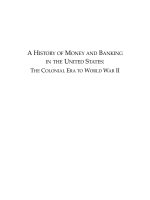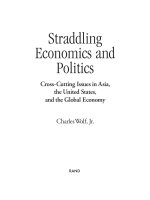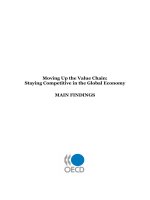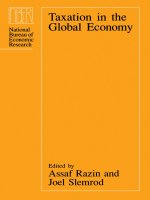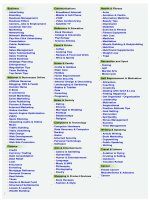Money and finance in the global economy
Bạn đang xem bản rút gọn của tài liệu. Xem và tải ngay bản đầy đủ của tài liệu tại đây (1.97 MB, 59 trang )
Money and finance in the global
economy
• The international monetary system is the body
of rules and procedures by which different
national currencies are exchanged for each other in
world trade.
• The global financial system (GFS) refers to those
financial institutions and regulations that act on
the international level.
• The main players are private (banks, hedge funds
etc) and public (central banks and government
departments) and international organizations
(the IMF, Bank for International Settlements etc).
Money and finance in the global
economy
• The international monetary system is closely tied
to the international finance system.
• Flows of international capital and FDI are
conducted in money. If there is a change in
exchange rates they inevitably impact on the value
of investment.
The role of the international
monetary system
• It requires a nation, or a group of nations, to
maintain and manage it; leading nations might
agree to entrust an international organization to
achieve this, see IMF and World Bank.
• It has to determine the way to solve imbalances of
national economies, by some agreed form of
adjustment.
• It has to provide sufficient international liquidity.
Countries need to rely on sufficient financial
reserves to meet sudden shocks.
The post-Bretton Wood
international monetary system
• Fixed exchange rates broke down in 1971. What
followed were fluctuating exchange rates with no
general rule on exchange rate adjustments.
The dollar remains the key reserve currency,
although the system is based on some cooperation
among the FED, the European Central Bank (the
Bundesbank before 1999) and the Bank of Japan.
• The IMF act as regulator of the world international
monetary system.
The post-Bretton Wood
international monetary system
• Many countries have chosen either to create monetary
unions (the euro), or to peg their currencies to the dollar
(dollar peg as in many South East Asian countries
before 1997).
• Some countries manage their currencies with currency
reserve boards, which means relinquishing control to
the IMF, which will cover their money supply with
dollars (for example Hong Kong in the 1990s, and
Argentina in early 2000s).
The International Monetary Fund
• The International Monetary Fund (IMF) oversees
exchange rates and balance of payments. It offers
financial and technical assistance when requested.
• Its headquarters are located in Washington D.C. and
offices around the world. It has currently 185 members.
• It came into existence in December 1945, when the first
29 countries signed its Articles of Agreement.
The International Monetary Fund
• An unwritten rule establishes that the IMF's managing
director must be European and that the president of the
World Bank must be from the US.
• The IMF is for the most part controlled by the major
Western Powers, especially the US, with voting rights
on the Executive board based on a quota which reflects
its monetary stake in the institution.
The post-Bretton Wood
international monetary system
• The desirable objectives of the international monetary
system are.
• 1) exchange rate stability.
• 2) being able to run an independent monetary (and more
broadly economic) national policy, for example a fiscal
deficit when needed to boost economic growth.
• 3) enjoy freedom of capital flows, in order to have a
more efficient financial system, international investment
etc. As we shall see this third point is now being
challenged.
The post-Bretton Wood
international monetary system
Desirable objectives of IMS:
• 1) exchange rate stability;
• 2) independent monetary policy;
• 3) free capital flows.
• The three objectives however are incompatible,
only two are achievable at the same time.
• Under Bretton Woods there was 1 and 2, but not 3.
• Currently most countries, have 2 and 3, but not 1.
• The Euro means that each UE member state enjoys
1 and 3, but not 2.
Flexible, fluctuating exchange rates
• Pros
• They prevent currency
misalignments
• Allow countries to
conduct independent
monetary policies
• Cons.
• They produce too
much fluctuations on a
day-to day basis:
volatility.
• They produce long
periods of currency
under or overevaluation, distorting
trade.
International monetary system: alternative
solutions
Possible alternatives:
•Return to gold. Advocated by extreme neo-liberals.
•Managed currencies. Imply limitations to the free flow of
capital. see Tobin tax.
•Regional monetary Unions.
•Currency pegs.
Financial markets are central
• Well functioning financial markets are a central
feature of a modern market economy. They allow
resources to be taken from people who do not
need them or can not use them to people who need
them and can use them.
• 1) they mobilize savings, 2) they allocate capital,
to finance investment; 3) they pool risk and
distribute risks to those who can bear them; 4)
they monitor managers.
Financial markets are risky and fragile
• Financial markets are fragile and vulnerable.
• They suffer from inadequate information.
• Banks have short term liabilities in domestic or
foreign currency, which are payable on demand,
while most of their assets are long-term, and
subject to fluctuations.
• Financial markets are liable to wild swings in
prices. They tend towards herd behaviour.
Capital flows in the global economy
Under Bretton Woods countries controlled their capital market.
Free capital flows started to materialize
• with the Eurodollar market in the 1960s. After the end of
Bretton Woods the situation gradually evolved with:
A) Liberalisation of financial markets. Scrapping of capital
controls.
B) Innovation in financial instruments (Derivates etc.)
Today huge amounts of capital is exchanged every day on
the foreign exchange market: in 2007 the daily volume of
foreign currency transactions was $ 3.2 trillion.
Liberalization of capital markets in the 1980s
and 1990s
• Since the late 1980s the IMF became a strong
supporter of free capital markets: it advised
countries that came under its influence to
dismantle controls over cross-border lending and
borrowing.
• The removal of capital controls would increase
the demand for services from the City and Wall
Street. The US and Britain pushed for capital
liberalization.
Liberalization of capital markets in
the 1980s and 1990s
• The EU during the 1980s turned towards capital
liberalization. During the late 1980s capital
controls had been removed in all the major
European countries. Free capital movements were
enshrined in the Maastricht Treaty.
• The OECD adopted free capital flows as part of it
Code of Liberalization of capital controls. New
member countries, such as Mexico and S.Korea,
adopted the Code.
Global finance: new developments,
opportunities and risks
• Today’s global financial movements are different from
those of the past, since they have no relation with
international trade.
• Financial globalisation has made all national economies
closely interdependent. It has also made available vast
financial resources for developing countries.
• A large share of global finance consists of short term
capital flows, which by definition are highly volatile and
speculative. Speculators can attack currencies whose
exchange rate is deemed to be non-credible.
Free capital flows
• Pros
• They improve the global
allocation of resources
• They provide an incentive
to governments to pursue
sound fiscal monetary
policy
• Cons
• International capital
markets do not allocate
resources efficiently.
Speculators and investors
tend to be irrational and
short-term.
• Global finance is
unregulated and lacks
institutional support
(standards, supervision,
lenders of last resort.
Tobin tax
• Already in 1978 James Tobin (a keynesian
economist from Yale) criticized “excessive”
financial capital mobility. These flows constrained
the ability of governments to pursue adequate
domestic economic policies.
• He recommended a tax on international currency
transactions: consisting in a small levy on each
transaction.
• Tobin met with considerable opposition but his
suggestion is being reconsidered in the light of the
recent massive global financial crises.
Financial crises: general outline
How do they break out?
•Speculation fuelled by euphoria over the performance
of a single sector or of a particular country’s economy
(herd psychology)
•Rise in profits and in investment.
•Prices rise and the velocity of exchanges accelerates,
generating a boom.
Financial crises: general outline
• Ad one point the bubble bursts. This can be the
result of a single event such as a bank failure or a
corporate bankruptcy.
The large increase in prices and profits suddenly
goes into reverse gear.
Overreaction generates a “run on the countries”.
Banks stop extending credit, and in fact demand
payment for the credits they earlier had granted,
i.e. there is a credit squeeze. Foreign capital moves
out. Currencies are forced to devalue.
Financial crises
1970s- early 1980s: Crisis in developing
countries, especially Latin America.
Build-up of high debt levels with Western banks, which had
used their lines of credit to recycle Petrodollars.
Starting in 1979, Paul Volcker, the Fed Chairman, raised
interests drastically to fight US inflation.
International banks followed suit, raised interest rates and
the unsustainable debt of many countries position was
exposed.
Japan: crisis of the 1990s
• At the end of the 1980s real estate prices rose by three times,
producing a real estate bubble. This uncovered one of the unspoken
factors of the Japanese economic miracle, i.e. the power of big
speculators, with ties to the criminal world as well as top politicians.
• Japan’s Central Bank responded first by raising interest rates and this
determined a steep fall of house prices in 1991. This was not,
however, accompanied by economic recovery, rather it was followed
by a creeping recession.
• In the next stage, interest rates were lowered, down to zero, in order
to jump start the economy. The State launched big public expenditure
programs, borrowing large quantities of money.
• The economy did not react as hoped. Japan’s economy was based on a
low rate of private consumption. GDP growth rates remained low,
below the economy’s growth potential. In other workds Japan had
fallen into a deflationary trap.
Japan’s growth rate.
